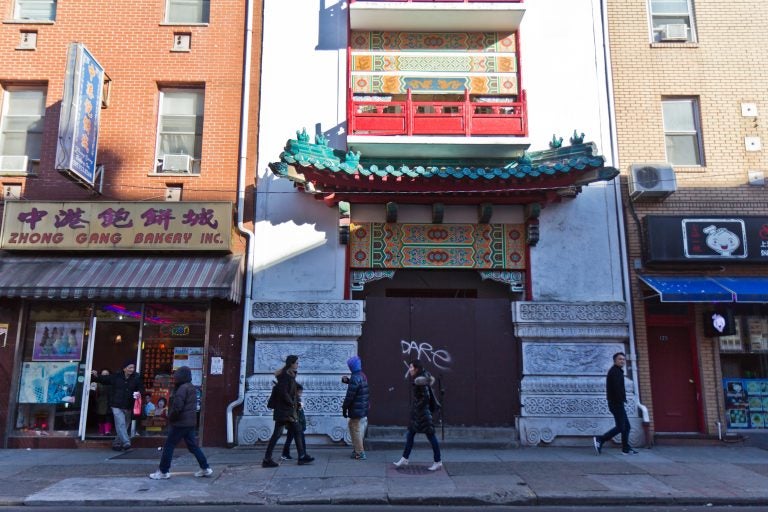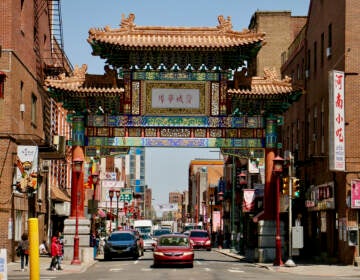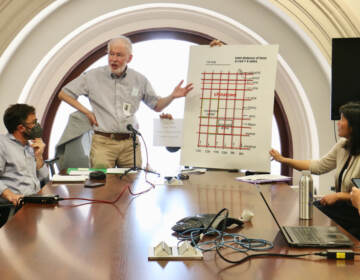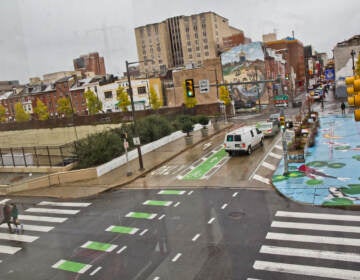Chinatown landmark spared the wrecking ball, for now
Redevelopment plans for a Chinatown landmark changed after community outcry. City planners are working with the owner on a new design.

The former Chinese Cultural & Community Center on North 10th Street. (Kimberly Paynter/WHYY)
This story originally appeared on PlanPhilly.
—
The Philadelphia Historical Commission is helping the owners of a Chinatown landmark remake plans for the pagoda-topped building after an earlier redevelopment proposal sparked community outcry.
A Historical Commission staffer said plans for the 125 N. 10th St. former Chinese Cultural and Community Center were withdrawn prior to a scheduled March 26 hearing and that city staff is working with the owner’s architect on a revamped design. The owner, PA Zhangs Associate, will return for a hearing once new plans are complete.
Nearly 7,000 people signed a Change.org petition created by the Philadelphia Chinatown Development Corporation urging the owner to keep the building intact. The owner never intended to tear down the building’s ornate stone facade or traditional Chinese glazed-tile top but preservationists said earlier plans to demolish everything but that front face would endanger the building’s integrity.
“If our community members want Chinatown to exist for our children, grandchildren, and future generations, we must stop the destruction of Chinatown and our historic buildings. The destruction of Chinatown will lead to the destruction of our history,” the petition reads.
Yue Wu, a community planner for PCDC, said that the owner told PCDC they don’t intend to knock down the building.
“They are willing to work with us,” Wu said. “We suggested they should use architects who are specialized in historic buildings.”
PA Zhang’s earlier plans show a new addition at the rear of the property that would support six residential housing units. A restaurant would occupy the front.
PA Zhangs Associate purchased the property for $1.8 million in May 2018. The property is estimated to be worth $2.1 million.
Wu said that as Chinatown real estate appreciates in value, buildings including many that are not recognized as historic under the city’s designation are at risk.
She pointed to 911 Race St., a handsome brick building that is not listed on the Philadelphia Register of Historic Places.
“The first Chinese business was opened at 911 Race Street,” Wu said. “Although the building is not the original one, the address is very significant.”
Though 911 Race and other important buildings may not meet the city’s current standards for designation on the register, Wu says many are worth saving,
“We are trying to preserve the affordability and historic landscape of Chinatown,” she said.
‘Disappearing Chinatowns’
A plan unveiled last week by city leaders pointed to a need for more protections in neighborhoods like Chinatown that are facing development pressures.
Julia Milan Shaw, the deputy director of Asian Arts Initiative, said Chinatowns across the country are facing pressures as urban real estate becomes a luxury commodity.
“Chinatown is a culturally and historically significant neighborhood and experiencing the squeeze of a rapidly developing Philadelphia, similar to what we are seeing in a national trend of ‘disappearing Chinatowns,’” she said. “As a neighborhood organization, we are working on programming that helps preserve a sense of that cultural history and feel that to destroy a property of historical significance would be a mistake.”
Wu said the threat posed by new development extends beyond buildings.
“We have a lot of low-income families living in this neighborhood,” she said. “We want to not only preserve the physical structure, but also the community…the connection…the people living here.”
The community center building, which sat vacant for many years, was originally constructed in the 19th century.
A significant period for the building was between 1955-2006 when the Chinatown YMCA operated on the second floor of the building. In 1966, T.T. Chang, founder of the Chinatown YMCA, purchased the building and formed the Chinese Cultural and Community Center.
In 1967 and 1971, the Chinese Cultural and Community Center gave the building its existing iconic Chinese architectural facade and detailed tile roof.
“It has a strong social history, and it’s important to keep this building,” Fon Wang, director of historic preservation at Ballinger said. “I think the reaction from the potential demo shows that Chinatown is a strong community.”
Wang teaches a historic preservation studio class at the University of Pennsylvania. Five years ago, her graduate students walked through the building to look at the existing conditions and drew up solutions to preserve the building.
“It’s definitely a task,” Wang said. “All architecture is complicated. You may have to take out pieces that need to be replaced, but you don’t have to demo to rehab.”
The property was listed on the Philadelphia Register of Historic Places in 2013.
WHYY is your source for fact-based, in-depth journalism and information. As a nonprofit organization, we rely on financial support from readers like you. Please give today.







